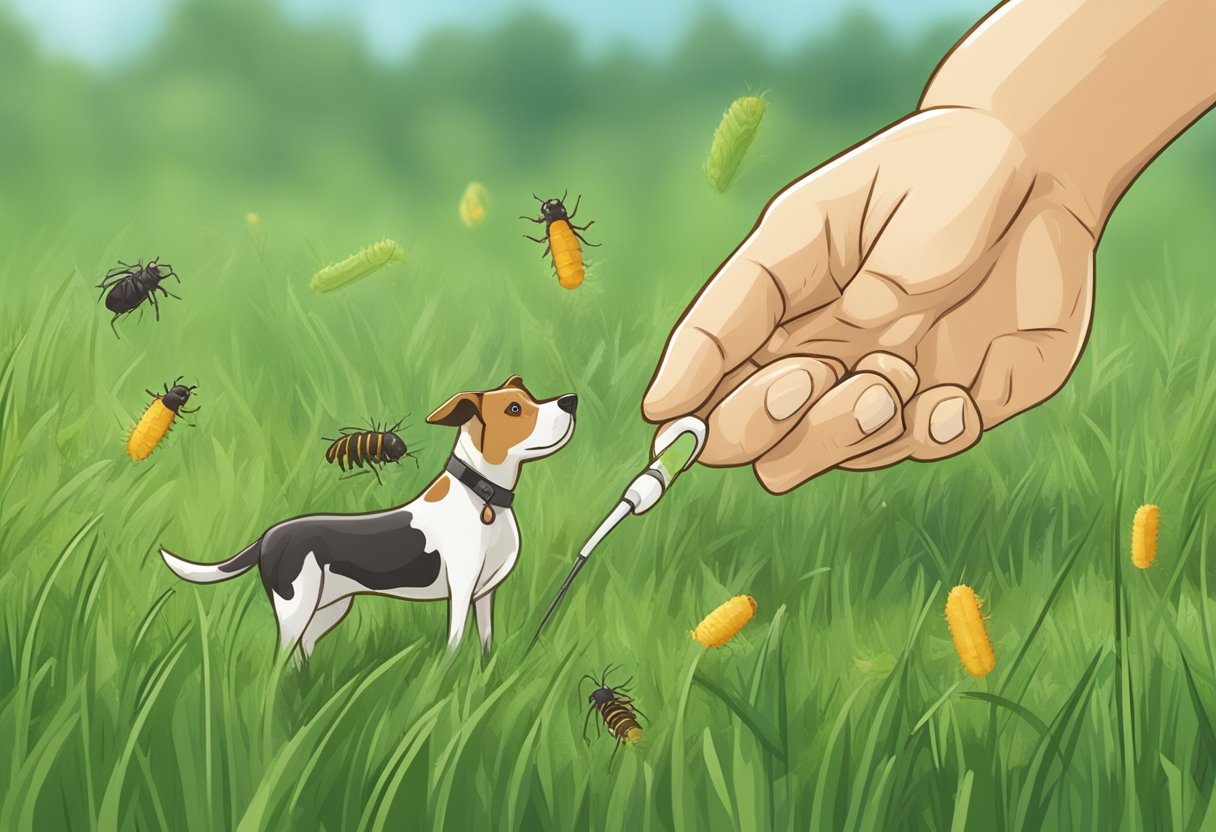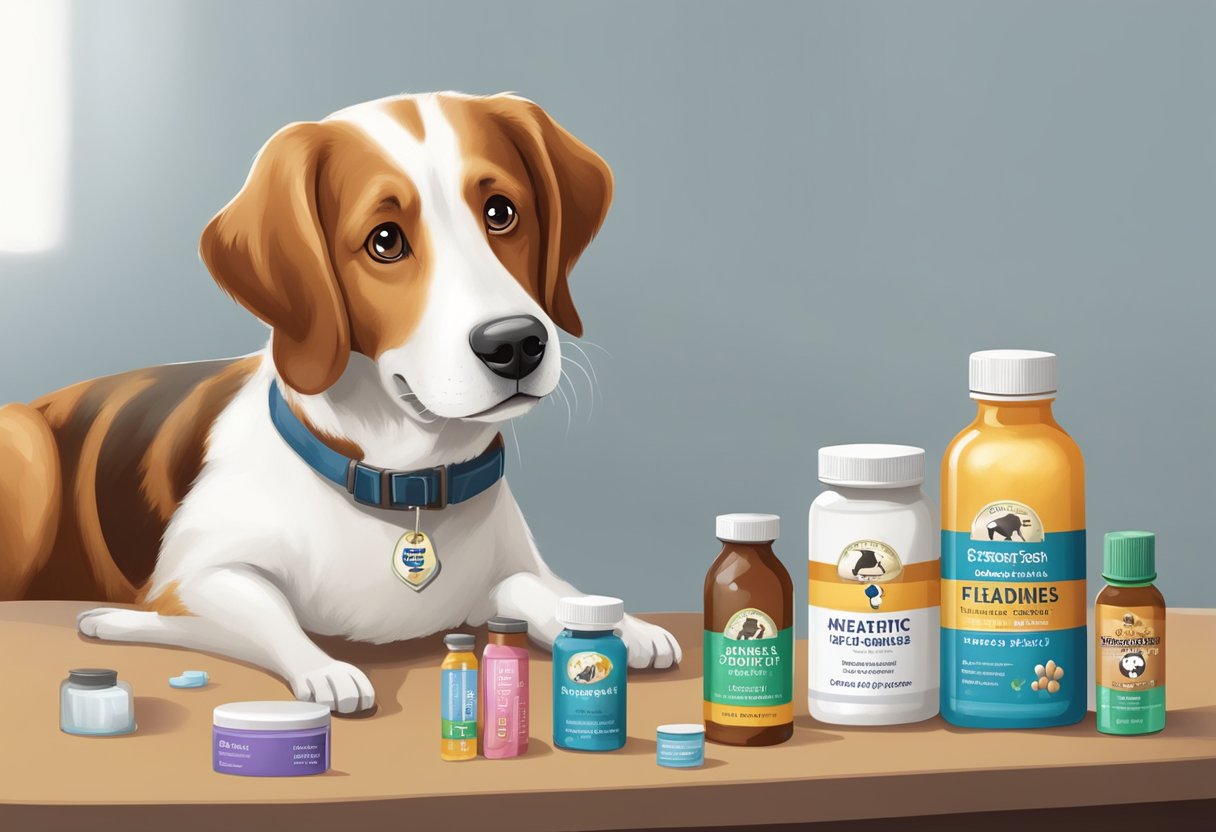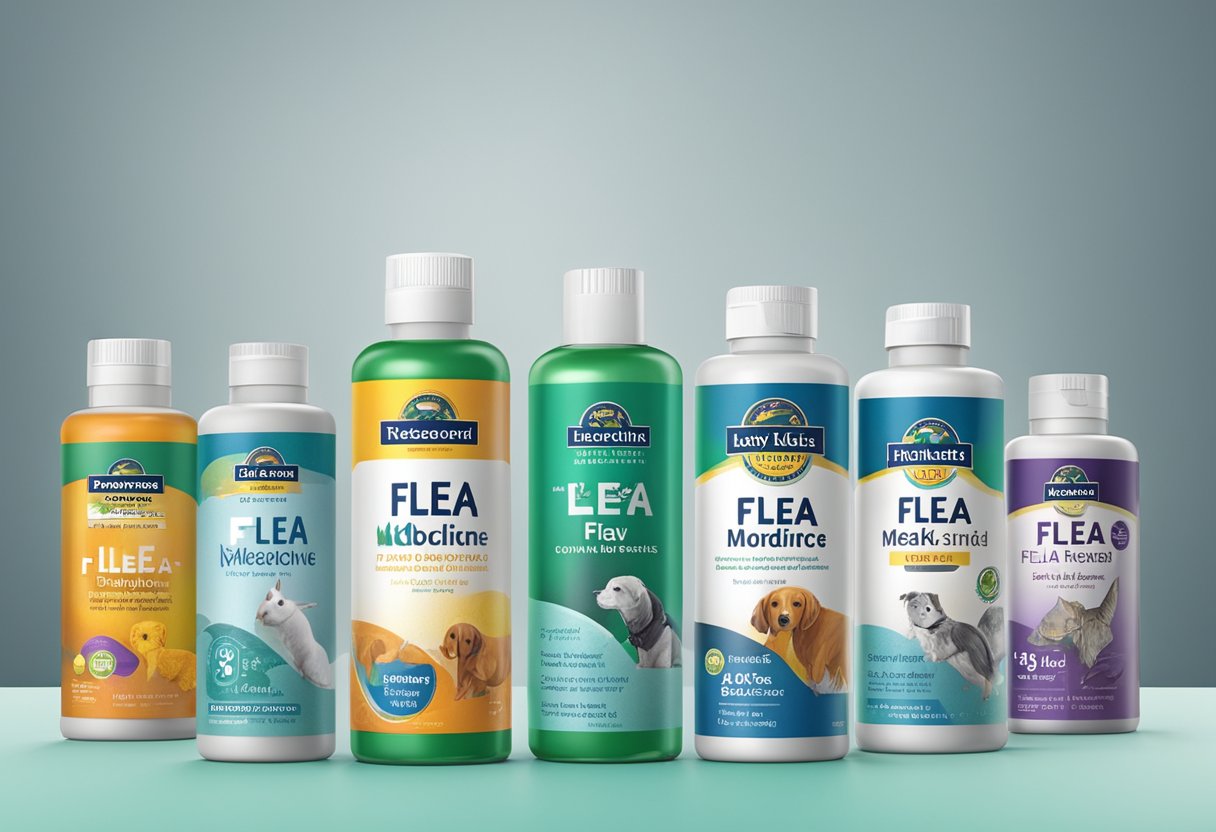Best Flea and Tick Medicine for Dogs: Expert Recommendations
Fleas and ticks are a common problem for dogs, and they can cause a range of health issues, from skin irritation to serious diseases. To protect your furry friend, it’s important to use a reliable flea and tick medicine. But with so many options on the market, it can be overwhelming to choose the right one.
When looking for the best flea and tick medicine for dogs, it’s important to consider several factors, including the type of medication, the age and weight of your dog, and any pre-existing health conditions. Some common options include topical treatments, oral medications, and collars. Each has its own benefits and drawbacks, so it’s important to do your research and consult with your veterinarian to find the best option for your dog.
Understanding Flea and Tick Infestations
Flea and tick infestations are a common problem for dogs, especially during the warmer months. These parasites not only cause discomfort for your furry friend, but they can also transmit diseases. Understanding the lifecycle of fleas and ticks, as well as the risks of infestations, can help you choose the best flea and tick medicine for your dog.
Lifecycle of Fleas and Ticks
Fleas and ticks have different lifecycles, but both can cause problems for your dog. Fleas go through four stages: egg, larva, pupa, and adult. The female flea lays eggs on the host animal, which then fall off into the environment. The eggs hatch into larvae, which feed on organic matter in the environment. The larvae then spin cocoons and become pupae, which can survive for months. The pupae eventually hatch into adult fleas, which jump onto a host animal to feed and lay eggs.
Ticks, on the other hand, have three stages: larva, nymph, and adult. The female tick lays eggs in the environment, which hatch into larvae. The larvae feed on a host animal, then molt into nymphs. The nymphs also feed on a host animal, then molt into adult ticks. Adult ticks feed on a host animal, mate, and lay eggs, starting the cycle over again.
Risks of Infestations for Dogs
Flea and tick infestations can cause a variety of problems for dogs. Flea bites can cause itching, skin irritation, and even anemia in severe cases. Ticks can transmit diseases such as Lyme disease, Rocky Mountain spotted fever, and ehrlichiosis. These diseases can cause symptoms such as fever, joint pain, and lethargy.
In addition to the health risks, flea and tick infestations can also be a nuisance for pet owners. Fleas can quickly infest a home, and their bites can cause itching and discomfort for humans as well as pets. Ticks can also be a problem in yards and outdoor spaces, making it difficult for dogs to enjoy time outside.
Overall, it is important to take flea and tick infestations seriously and take steps to prevent them. By understanding the lifecycle of these parasites and the risks they pose, you can choose the best flea and tick medicine for your dog and help keep them healthy and comfortable.
Types of Flea and Tick Medicines
When it comes to protecting dogs from fleas and ticks, there are several types of medicines available. Each type has its own unique way of working, and some may be more effective than others depending on the situation. Here are some of the most common types of flea and tick medicines for dogs:
Topical Treatments
Topical treatments are applied directly to the skin of the dog, usually between the shoulder blades. These treatments work by spreading throughout the dog’s body and killing fleas and ticks on contact. Some popular topical treatments include Frontline Plus, Advantage II, and K9 Advantix II. These treatments are typically applied once a month and are waterproof, so they can still be effective after swimming or bathing.
Oral Medications
Oral medications are given to dogs in the form of pills or chewables. These medications work by circulating through the dog’s bloodstream and killing fleas and ticks when they bite the dog. Some popular oral medications include NexGard, Bravecto, and Simparica. These medications are typically given once a month and may require a prescription from a veterinarian.
Collars
Flea and tick collars are worn around the dog’s neck and work by releasing chemicals that repel or kill fleas and ticks. Some popular flea and tick collars include Seresto, Scalibor, and Preventic. These collars can be effective for up to eight months and are waterproof, so they can still be effective after swimming or bathing.
Shampoos and Dips
Flea and tick shampoos and dips are applied to the dog’s coat during a bath. These products work by killing fleas and ticks on contact. Some popular flea and tick shampoos and dips include Adams Plus Flea -amp; Tick Shampoo with Precor, Hartz UltraGuard Plus Flea -amp; Tick Shampoo, and Vet’s Best Flea and Tick Waterless Bath Foam. These products may need to be used more frequently than other types of flea and tick medicines.
Sprays and Powders
Flea and tick sprays and powders are applied directly to the dog’s coat and work by killing fleas and ticks on contact. Some popular flea and tick sprays and powders include Adams Plus Flea -amp; Tick Spray, Vet’s Best Flea and Tick Home Spray, and Zodiac Flea -amp; Tick Powder. These products may need to be used more frequently than other types of flea and tick medicines.
It is important to note that different types of flea and tick medicines may be more effective in different situations. For example, if a dog has a severe flea infestation, a flea and tick collar may not be enough to provide adequate protection. It is also important to follow the instructions on the packaging carefully and to consult with a veterinarian before using any flea and tick medicines, especially if the dog has any underlying health conditions.
Factors to Consider When Choosing Medicine
When it comes to choosing the best flea and tick medicine for dogs, there are several factors to consider. Here are some important factors to keep in mind:
Dog’s Age, Weight, and Health
Before selecting a flea and tick medicine, it’s important to consider the age, weight, and overall health of your dog. Some medicines may not be suitable for puppies or senior dogs, while others may be too strong for dogs with certain health conditions. Always consult with your veterinarian before giving any medicine to your dog.
Medicine Efficacy
The efficacy of the medicine is another important factor to consider. Look for medicines that are proven to be effective against fleas, ticks, and other pests. Some medicines may only kill adult fleas, while others may also target flea eggs and larvae. It’s important to choose a medicine that provides comprehensive protection against all stages of fleas and ticks.
Duration of Protection
The duration of protection is also an important consideration. Some medicines may provide protection for just a few weeks, while others may last for several months. Consider how often you want to administer the medicine and choose a product that fits your lifestyle and schedule.
Application Method
Finally, consider the application method of the medicine. Some medicines come in the form of pills or chewables, while others are applied topically to the skin. Some dogs may prefer one method over the other, so it’s important to choose a product that your dog is comfortable with. Additionally, some topical medicines may require you to keep your dog dry for a certain period of time after application, so be sure to read the instructions carefully.
By considering these factors, you can choose the best flea and tick medicine for your dog’s individual needs. Remember to always consult with your veterinarian before giving any medicine to your dog.
Popular Flea and Tick Medicine Brands
When it comes to flea and tick medicine for dogs, there are several popular brands to choose from. Each brand has its own unique formula and method of application. Here are some of the most popular brands on the market:
Brand A
Brand A is a well-known name in the world of flea and tick medicine for dogs. Their products are available in both topical and oral forms. The topical solutions are applied directly to the dog’s skin, while the oral medications are given to the dog in the form of a pill.
One of the most popular products from Brand A is their topical solution, which is known for its fast-acting formula. This solution is designed to kill fleas and ticks within hours of application, and it provides long-lasting protection against future infestations.
Brand B
Brand B is another popular name in the world of flea and tick medicine for dogs. Their products are available in both topical and oral forms, and they are known for their effectiveness in killing fleas and ticks.
One of the most popular products from Brand B is their oral medication, which is designed to kill fleas and ticks for up to 12 weeks. This medication is given to the dog in the form of a chewable tablet, and it is easy to administer.
Brand C
Brand C is a newer name in the world of flea and tick medicine for dogs, but they have quickly gained a reputation for their effective products. Their products are available in both topical and oral forms, and they are designed to kill fleas and ticks quickly and effectively.
One of the most popular products from Brand C is their topical solution, which is designed to kill fleas and ticks within hours of application. This solution is also waterproof, so it will continue to be effective even if the dog gets wet.
Overall, these three brands are some of the most popular and effective options for flea and tick medicine for dogs. It is important to choose a product that is appropriate for your dog’s age, weight, and health condition, and to follow the instructions carefully to ensure that the medication is used safely and effectively.
Safety and Side Effects
When it comes to flea and tick medicine for dogs, safety is a top concern. While these medications are generally safe and effective, there are some potential side effects to be aware of. It’s important to follow the instructions carefully and talk to your veterinarian if you have any concerns.
Common Side Effects
Some common side effects of flea and tick medicine for dogs include:
- Vomiting
- Diarrhea
- Loss of appetite
- Lethargy
- Itching or irritation at the application site
In rare cases, more serious side effects such as seizures or allergic reactions can occur. If you notice any unusual symptoms in your dog after giving them flea and tick medicine, contact your veterinarian right away.
Safety Precautions
To minimize the risk of side effects, it’s important to follow these safety precautions:
- Only use flea and tick medicine that is specifically formulated for dogs. Never use products designed for cats or other animals.
- Follow the instructions carefully, including the recommended dosage and frequency of application.
- Don’t apply flea and tick medicine to puppies under 8 weeks old without consulting a veterinarian.
- Keep flea and tick medicine out of reach of children and other pets.
- Store flea and tick medicine according to the instructions on the packaging.
By following these safety precautions and being aware of the potential side effects, you can help ensure that your dog stays safe and healthy while using flea and tick medicine. However, if you have any concerns or notice any unusual symptoms in your dog, don’t hesitate to contact your veterinarian.
Application Tips and Best Practices
When it comes to applying flea and tick medicine to your furry friend, there are a few tips and best practices to keep in mind to ensure the medication is effective and safe.
Follow the Instructions
The first and most important tip is to always follow the instructions on the medication label. Different medications may have different application methods and dosages, so it’s essential to read and follow the instructions carefully.
Apply to Clean Skin
Before applying the medication, make sure your dog’s skin is clean and dry. Bathing your dog before applying the medication can help remove any dirt or debris that may prevent the medication from reaching the skin.
Avoid Contact with Eyes and Mouth
When applying the medication, be careful to avoid getting it in your dog’s eyes or mouth. If the medication accidentally gets in their eyes or mouth, rinse thoroughly with water.
Monitor for Side Effects
After applying the medication, monitor your dog for any side effects, such as skin irritation or vomiting. If you notice any unusual behavior or symptoms, contact your veterinarian immediately.
Consistency is Key
Consistency is key when it comes to flea and tick prevention. Make sure to apply the medication at the recommended intervals and continue treatment throughout the year, even during the winter months, as fleas and ticks can still be present.
By following these application tips and best practices, you can help ensure that your dog is protected from fleas and ticks while also keeping them safe and healthy.
When to See a Vet
While there are many over-the-counter flea and tick medications available, it’s important to know when to see a vet. If your dog is experiencing severe itching, hair loss, or skin irritation, it may be a sign of an allergic reaction to flea bites. In this case, a vet may recommend a prescription medication or a change in diet to help alleviate these symptoms.
Additionally, if your dog is on medication for other conditions, it’s important to check with a vet before administering any flea and tick medication. Some medications can interact with each other, and a vet can help determine what is safe for your dog.
If you notice any unusual behavior in your dog after administering flea and tick medication, such as lethargy or loss of appetite, it’s important to contact a vet immediately. These can be signs of an adverse reaction to the medication.
Finally, if you live in an area with a high concentration of fleas and ticks, it’s important to have your dog regularly checked by a vet. They can recommend the best course of action for flea and tick prevention, and can catch any infestations early before they become a larger problem.
Overall, while over-the-counter flea and tick medications can be effective, it’s important to know when to see a vet for the best care for your furry friend.
Preventative Measures and Home Remedies
While there are several effective flea and tick medications available for dogs, there are also preventative measures and home remedies that can help keep these pests at bay. Here are a few options to consider:
-
Regular grooming: Regular grooming can help prevent flea and tick infestations. Brushing your dog’s coat regularly can help remove any fleas or ticks that may be present, and it can also help you spot any potential issues early on.
-
Vacuuming: Vacuuming your home regularly can help remove any fleas or ticks that may be present. Be sure to vacuum areas where your dog spends the most time, including their bedding and any furniture they may use.
-
Natural remedies: There are several natural remedies that may help prevent flea and tick infestations. For example, some people swear by using a mixture of apple cider vinegar and water as a flea and tick repellent. Others recommend using essential oils, such as lavender or peppermint, to repel these pests.
-
Diatomaceous earth: Diatomaceous earth is a type of sedimentary rock that is often used as a natural pesticide. When applied to your dog’s coat or bedding, it can help kill fleas and ticks.
-
Collars and sprays: In addition to medications, there are also several flea and tick collars and sprays available that can help prevent infestations. These products work by releasing chemicals that repel fleas and ticks, making it more difficult for them to attach to your dog’s skin.
While these preventative measures and home remedies can be effective, it’s important to note that they may not be enough on their own. For the best protection against fleas and ticks, it’s recommended that you use a combination of preventative measures, home remedies, and medication. Be sure to talk to your veterinarian to determine the best course of action for your dog.
Frequently Asked Questions
What are the most effective over-the-counter flea and tick preventatives for dogs?
There are many over-the-counter flea and tick preventatives for dogs available in the market. However, some of the most effective ones are Frontline Plus, K9 Advantix II, and Advantage II. These products use different active ingredients to kill fleas and ticks. It’s important to consult with a veterinarian to determine which product is best suited for a specific dog.
How do flea and tick medications potentially harm dogs, and how can I avoid these risks?
Flea and tick medications can potentially harm dogs if not used correctly. Some common side effects include skin irritation, vomiting, and diarrhea. It’s important to follow the instructions provided with the medication and consult with a veterinarian before administering any medication to a dog. Avoid using flea and tick medications designed for other animals, such as cats, on dogs.
What are the key differences between topical and oral flea and tick treatments for dogs?
Topical flea and tick treatments are applied directly to a dog’s skin, while oral treatments are ingested by the dog. Topical treatments tend to work faster, but oral treatments provide longer-lasting protection. It’s important to consult with a veterinarian to determine which type of treatment is best suited for a specific dog.
Which flea and tick collars are recommended by veterinarians for long-term protection?
Some flea and tick collars that are recommended by veterinarians for long-term protection include Seresto, Scalibor, and Preventic. These collars use different active ingredients to kill fleas and ticks. It’s important to consult with a veterinarian to determine which collar is best suited for a specific dog.
What should I look for in a flea and tick shampoo to ensure it’s safe and effective for my dog?
When selecting a flea and tick shampoo, it’s important to look for a product that is specifically designed for dogs and contains safe and effective ingredients. Look for shampoos that contain natural ingredients such as neem oil, cedar oil, or citrus extracts. It’s important to follow the instructions provided with the shampoo and consult with a veterinarian before using any new product on a dog.
How can I protect my dog from fleas, ticks, and heartworms simultaneously with minimal risk?
There are several products available that can protect dogs from fleas, ticks, and heartworms simultaneously. Some examples include Trifexis, Sentinel, and Revolution. These products are prescription-only and require a veterinarian’s recommendation. It’s important to consult with a veterinarian to determine which product is best suited for a specific dog.




